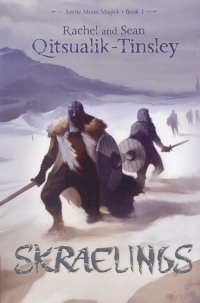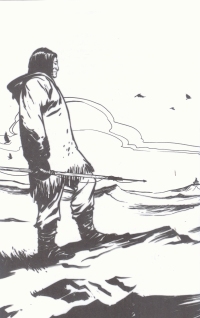| ________________
CM . . .
. Volume XX Number 35. . . .May 9, 2014
excerpt:
Rachel and Sean Qitsualik-Tinsley’s new historical fiction novel, Skraelings, takes readers through a quick and exciting adventure in the Arctic at the time of Viking exploration. The Qitsualik-Tinsleys are scholars and authors who specialize in Inuit culture and mythology, and they bring this depth of knowledge to this work to create a thoughtful and unique story of the north.
The authors try to convey the mystery and uncertainty that Kannujaq feels in this new situation by having the readers learn about most things through Kannujaq’s experience. As seen in the excerpt above, the interruptions in Kannujaq’s story by the modern benevolent storyteller are typically only used to tell the reader information necessary to better understand the story from Kannujaq’s viewpoint. It is often left up to the reader to piece things together to give the story greater historical context. For example, while Kannujaq realizes the giants attacking the Tuniit village are indeed foreign men, it is his naïve descriptions of the armor and ship details, combined with a harsh black and white full-page illustration of Vikings, that allow the reader to understand the historical import of the meeting. At only 78 pages long (eight of which are illustrations by Andrew Trabbold), Skraelings is a very short and exciting read. At times, the storytelling seems to suffer from its brevity, and the second half seems overly plot-driven and rushed. The five-page glossary following the story is a positive addition and provides readers with pronunciations and historical background. For instance, readers will be saddened to learn that the Tuniit are now extinct. While the novel may feel too short for some readers, the promise of the book’s being the first part of a series may be a consolation to some. This often-overlooked perspective in historical fiction will be a welcome read for many young people. Recommended. Beth Wilcox, a graduate from the MA in Children’s Literature program at the University of British Columbia, is currently teaching in Prince George, BC.
To comment
on this title or this review, send mail to cm@umanitoba.ca.
Copyright © the Manitoba Library Association. Reproduction for personal
use is permitted only if this copyright notice is maintained. Any
other reproduction is prohibited without permission.
NEXT REVIEW |
TABLE OF CONTENTS FOR THIS ISSUE
- May 9, 2014.
AUTHORS |
TITLES |
MEDIA REVIEWS |
PROFILES |
BACK ISSUES |
SEARCH |
CMARCHIVE |
HOME |

 The novel follows Kannujaq, a young Inuit man who is exploring the Land with his team of dogs when he comes across a village of the legendary Tuniit, a nation that Kannujaq has only heard about in stories. Unlike Kannujaq’s people, the Tuniit are not nomadic, and it takes some time in Kannujaq’s interaction with the people for him to realize that they are indeed human. Kannujaq quickly realizes that the Tuniit are in danger and is convinced by a young Tuniit shaman to help save the people from the repeated attacks of mysterious men who are armed with metal weapons. The word “Skraelings”, meaning “weaklings”, is the battle-cry of the foreigners as they attack the Tuniit village.
The novel follows Kannujaq, a young Inuit man who is exploring the Land with his team of dogs when he comes across a village of the legendary Tuniit, a nation that Kannujaq has only heard about in stories. Unlike Kannujaq’s people, the Tuniit are not nomadic, and it takes some time in Kannujaq’s interaction with the people for him to realize that they are indeed human. Kannujaq quickly realizes that the Tuniit are in danger and is convinced by a young Tuniit shaman to help save the people from the repeated attacks of mysterious men who are armed with metal weapons. The word “Skraelings”, meaning “weaklings”, is the battle-cry of the foreigners as they attack the Tuniit village.